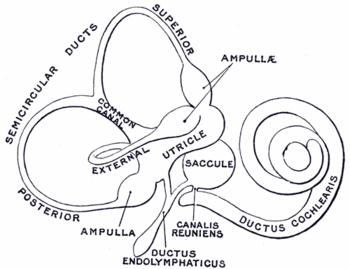Vertigo (medical): Difference between revisions
imported>Robert Badgett No edit summary |
imported>Robert Badgett |
||
| Line 3: | Line 3: | ||
'''Vertigo''' is a well-recognized [[medicine|medical]] condition that consists of "illusion of movement, either of the external world revolving around the individual or of the individual revolving in space".<ref>{{MeSH}}</ref> Most often, patients with vertigo "see" the room and world spinning around them, but sometimes that hallucination of movement is centered on the body, instead, and the patient feels as if he or she is spinning within the room or other setting. In severe vertigo, there is often nausea and even vomiting. | '''Vertigo''' is a well-recognized [[medicine|medical]] condition that consists of "illusion of movement, either of the external world revolving around the individual or of the individual revolving in space".<ref>{{MeSH}}</ref> Most often, patients with vertigo "see" the room and world spinning around them, but sometimes that hallucination of movement is centered on the body, instead, and the patient feels as if he or she is spinning within the room or other setting. In severe vertigo, there is often nausea and even vomiting. | ||
== | ==Causes/etiology== | ||
Benign paroxysmal positional vertigo (BPPV) is "the most common cause of recurrent vertigo".<ref name="pmid18505980">{{cite journal |author=Fife TD, Iverson DJ, Lempert T, ''et al'' |title=Practice Parameter: Therapies for benign paroxysmal positional vertigo (an evidence-based review): Report of the Quality Standards Subcommittee of the American Academy of Neurology |journal=Neurology |volume=70 |issue=22 |pages=2067–74 |year=2008 |month=May |pmid=18505980 |doi=10.1212/01.wnl.0000313378.77444.ac |url=http://www.neurology.org/cgi/content/full/70/22/2067 |issn=}}</ref> | Benign paroxysmal positional vertigo (BPPV) is "the most common cause of recurrent vertigo".<ref name="pmid18505980">{{cite journal |author=Fife TD, Iverson DJ, Lempert T, ''et al'' |title=Practice Parameter: Therapies for benign paroxysmal positional vertigo (an evidence-based review): Report of the Quality Standards Subcommittee of the American Academy of Neurology |journal=Neurology |volume=70 |issue=22 |pages=2067–74 |year=2008 |month=May |pmid=18505980 |doi=10.1212/01.wnl.0000313378.77444.ac |url=http://www.neurology.org/cgi/content/full/70/22/2067 |issn=}}</ref> | ||
Revision as of 08:36, 29 May 2008
Vertigo is a well-recognized medical condition that consists of "illusion of movement, either of the external world revolving around the individual or of the individual revolving in space".[1] Most often, patients with vertigo "see" the room and world spinning around them, but sometimes that hallucination of movement is centered on the body, instead, and the patient feels as if he or she is spinning within the room or other setting. In severe vertigo, there is often nausea and even vomiting.
Causes/etiology
Benign paroxysmal positional vertigo (BPPV) is "the most common cause of recurrent vertigo".[2]
Unusual diagnoses causing vertigo
Pathophysiology
Benign positional vertigo
Most cases of benign positional vertigo are due to canaliths or otoliths (calcium carbonate crystals) in the posterior canal that stimulate the cupula. Disease of the horizontal canal accounts for 10-17% of cases.[2]
Diagnosis
Skew deviation (vertical misalignment) suggests a central lesion.[3]
Benign positional vertigo
The Dix–Hallpike maneuver can diagnose positional vertigo (BPPV):[2]
- Posterior canal BPPV causes "upbeating and torsional nystagmus with the top pole of rotation beating toward the affected (downside) ear"[2]
- Horizontal canal BPPV causes "horizontal geotropic (toward the ground) or apogeotropic (away from the ground) direction-changing paroxysmal positional nystagmus"[2] Disease of the horizontal canal is better detected by the supine head roll test or (Pagnini–McClure maneuver).[2]
- Anterior canal BPPV
Treatment
Benign positional vertigo
Clinical practice guidelines by the American Academy of Neurology address the treatment of benign positional vertigo.[2] The guidelines state:
- For posterior semicircular canal disease, canalith repositioning procedure may be used.
- For horizontal semicircular canal disease, the roll maneuver (Lempert maneuver or barbecue roll maneuver) may be used.
References
- ↑ Anonymous (2025), Vertigo (medical) (English). Medical Subject Headings. U.S. National Library of Medicine.
- ↑ 2.0 2.1 2.2 2.3 2.4 2.5 2.6 Fife TD, Iverson DJ, Lempert T, et al (May 2008). "Practice Parameter: Therapies for benign paroxysmal positional vertigo (an evidence-based review): Report of the Quality Standards Subcommittee of the American Academy of Neurology". Neurology 70 (22): 2067–74. DOI:10.1212/01.wnl.0000313378.77444.ac. PMID 18505980. Research Blogging.
- ↑ Cnyrim CD, Newman-Toker D, Karch C, Brandt T, Strupp M (2008). "Bedside differentiation of vestibular neuritis from central "vestibular pseudoneuritis"". J. Neurol. Neurosurg. Psychiatr. 79 (4): 458-60. DOI:10.1136/jnnp.2007.123596. PMID 18344397. Research Blogging.
